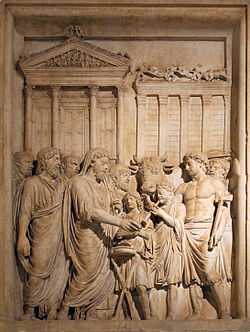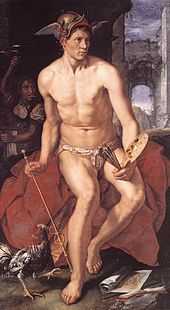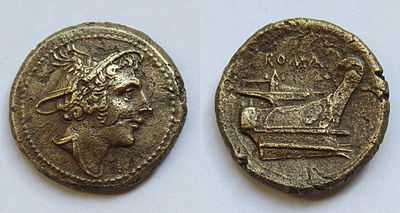Mercury (mythology)
| Mercury | |
|---|---|
| God of financial gain, commerce, eloquence (poetry), messages/communication (divination), travelers, boundaries, luck, trickery and thieves | |
|
Early Roman bronze statuette of Mercury, found near Huis, France (British Museum) | |
| Consort | Larunda |
| Parents | Maia and Jupiter |
| Children | Lares |
| Greek equivalent | Hermes |
Mercury (/ˈmɜrkjʉri/; Latin: Mercurius ![]() listen ) is a major Roman god, being one of the Dii Consentes within the ancient Roman pantheon. He is the patron god of financial gain, commerce, eloquence (and thus poetry), messages/communication (including divination), travelers, boundaries, luck, trickery and thieves; he is also the guide of souls to the underworld.[1][2]
He was considered the son of Maia and Jupiter in Roman mythology. His name is possibly related to the Latin word merx ("merchandise"; compare merchant, commerce, etc.), mercari (to trade), and merces (wages); another possible connection is the Proto-Indo-European root merĝ- for "boundary, border" (cf. Old English "mearc", Old Norse "mark" and Latin "margō") and Greek οὖρος (by analogy of Arctūrus/Ἀρκτοῦρος), as the "keeper of boundaries," referring to his role as bridge between the upper and lower worlds. In his earliest forms, he appears to have been related to the Etruscan deity Turms, both of which share characteristics with the Greek god Hermes. In Virgil's Aeneid, Mercury reminds Aeneas of his mission to found the city of Rome. In Ovid's Fasti, Mercury is assigned to escort the nymph Larunda to the underworld. Mercury, however, fell in love with Larunda and made love to her on the way. Larunda thereby became mother to two children, referred to as the Lares, invisible household gods.
listen ) is a major Roman god, being one of the Dii Consentes within the ancient Roman pantheon. He is the patron god of financial gain, commerce, eloquence (and thus poetry), messages/communication (including divination), travelers, boundaries, luck, trickery and thieves; he is also the guide of souls to the underworld.[1][2]
He was considered the son of Maia and Jupiter in Roman mythology. His name is possibly related to the Latin word merx ("merchandise"; compare merchant, commerce, etc.), mercari (to trade), and merces (wages); another possible connection is the Proto-Indo-European root merĝ- for "boundary, border" (cf. Old English "mearc", Old Norse "mark" and Latin "margō") and Greek οὖρος (by analogy of Arctūrus/Ἀρκτοῦρος), as the "keeper of boundaries," referring to his role as bridge between the upper and lower worlds. In his earliest forms, he appears to have been related to the Etruscan deity Turms, both of which share characteristics with the Greek god Hermes. In Virgil's Aeneid, Mercury reminds Aeneas of his mission to found the city of Rome. In Ovid's Fasti, Mercury is assigned to escort the nymph Larunda to the underworld. Mercury, however, fell in love with Larunda and made love to her on the way. Larunda thereby became mother to two children, referred to as the Lares, invisible household gods.
Mercury has influenced the name of many things in a variety of scientific fields, such as the planet Mercury, and the element mercury. The word mercurial is commonly used to refer to something or someone erratic, volatile or unstable, derived from Mercury's swift flights from place to place. He is often depicted holding the caduceus in his left hand.
History
| Religion in ancient Rome |
|---|
 |
| Practices and beliefs |
| Priesthoods |
| Deities |
|
| Related topics |
Mercury did not appear among the numinous di indigetes of early Roman religion. Rather, he subsumed the earlier Dei Lucrii as Roman religion was syncretized with Greek religion during the time of the Roman Republic, starting around the 4th century BC. From the beginning, Mercury had essentially the same aspects as Hermes, wearing winged shoes (talaria) and a winged hat (petasos), and carrying the caduceus, a herald's staff with two entwined snakes that was Apollo's gift to Hermes. He was often accompanied by a cockerel, herald of the new day, a ram or goat, symbolizing fertility, and a tortoise, referring to Mercury's legendary invention of the lyre from a tortoise shell.

Like Hermes, he was also a god of messages, eloquence and of trade, particularly of the grain trade. Mercury was also considered a god of abundance and commercial success, particularly in Gaul, where he was said to have been particularly revered.[3] He was also, like Hermes, the Romans' psychopomp, leading newly deceased souls to the afterlife. Additionally, Ovid wrote that Mercury carried Morpheus' dreams from the valley of Somnus to sleeping humans.[4]
Archeological evidence from Pompeii suggests that Mercury was among the most popular of Roman gods.[5] The god of commerce was depicted on two early bronze coins of the Roman Republic, the Sextans and the Semuncia.[6]

Syncretism
When they described the gods of Celtic and Germanic tribes, rather than considering them separate deities, the Romans interpreted them as local manifestations or aspects of their own gods, a cultural trait called the interpretatio Romana. Mercury in particular was reported as becoming extremely popular among the nations the Roman Empire conquered; Julius Caesar wrote of Mercury being the most popular god in Britain and Gaul, regarded as the inventor of all the arts.[7] This is probably because in the Roman syncretism, Mercury was equated with the Celtic god Lugus, and in this aspect was commonly accompanied by the Celtic goddess Rosmerta. Although Lugus may originally have been a deity of light or the sun (though this is disputed), similar to the Roman Apollo, his importance as a god of trade made him more comparable to Mercury, and Apollo was instead equated with the Celtic deity Belenus.[4]
Romans associated Mercury with the Germanic god Wotan, by interpretatio Romana; 1st-century Roman writer Tacitus identifies him as the chief god of the Germanic peoples.[8]
In Celtic areas, Mercury was sometimes portrayed with three heads or faces, and at Tongeren, Belgium, a statuette of Mercury with three phalli was found, with the extra two protruding from his head and replacing his nose; this was probably because the number 3 was considered magical, making such statues good luck and fertility charms. The Romans also made widespread use of small statues of Mercury, probably drawing from the ancient Greek tradition of hermae markers.
Names and epithets

Mercury is known to the Romans as Mercurius and occasionally in earlier writings as Merqurius, Mirqurios or Mircurios, had a number of epithets representing different aspects or roles, or representing syncretisms with non-Roman deities. The most common and significant of these epithets included the following:
- Mercurius Artaios, a combination of Mercury with the Celtic god Artaios, a deity of bears and hunting who was worshiped at Beaucroissant, France.[9]
- Mercurius Arvernus, a combination of the Celtic Arvernus with Mercury. Arvernus was worshiped in the Rhineland, possibly as a particular deity of the Arverni tribe, though no dedications to Mercurius Arvernus occur in their territory in the Auvergne region of central France.[9]
- Mercurius Cissonius, a combination of Mercury with the Celtic god Cissonius, who is written of in the area spanning from Cologne, Germany to Saintes, France.[9]
- Mercurius Esibraeus, a combination of the Iberian deity Esibraeus with the Roman deity Mercury. Esibraeus is mentioned only in an inscription found at Medelim, Portugal, and is possibly the same deity as Banda Isibraiegus, who is invoked in an inscription from the nearby village of Bemposta.[10]
- Mercurius Gebrinius, a combination of Mercury with the Celtic or Germanic Gebrinius, known from an inscription on an altar in Bonn, Germany.[9]
- Mercurius Moccus, from a Celtic god, Moccus, who was equated with Mercury, known from evidence at Langres, France. The name Moccus ("pig") implies that this deity was connected to boar-hunting.[9]
- Mercurius Visucius, a combination of the Celtic god Visucius with the Roman god Mercury, attested in an inscription from Stuttgart, Germany. Visucius was worshiped primarily in the frontier area of the empire in Gaul and Germany. Although he was primarily associated with Mercury, Visucius was also sometimes linked to the Roman god Mars, as a dedicatory inscription to "Mars Visucius" and Visucia, Visicius' female counterpart, was found in Gaul.[9][11]
Mercury's net
Vulcan created a net out of unbreakable steel so that he could catch Venus, the goddess of love and beauty, and Mars, the god of war, in the act of making love. He was jealous of their relationship, because Venus was his beloved wife. Vulcan managed to catch them but, afterwards, Mercury stole the net from the blacksmith god so that he could catch Chloris, a nymph whom he admired. Chloris was tasked with flying after the sun while it rose and scattering lilies, roses and violets behind it. Mercury lay in wait for at least several days until he caught her wing in the net over an unnamed great river in Ethiopia. Mercury then gave the net to the temple of Anubis at Canopus to protect the sacred spot. In Ludovico Ariosto's Orlando Furioso, the net is stolen 3,000 years later by Caligorant, who goes on to destroy the temple and the city.[12]
Temple
Mercury's temple in Rome was situated in the Circus Maximus, between the Aventine and Palatine hills, and was built in 495 BC.[13]
That year saw disturbances at Rome between the patrician senators and the plebeians, which led to a secession of the plebs in the following year. At the completion of its construction, a dispute emerged between the consuls Appius Claudius Sabinus Inregillensis and Publius Servilius Priscus Structus as to which of them should have the honour of dedicating the temple. The senate referred the decision to the popular assembly, and also decreed that whichever was chosen should also exercise additional duties, including presiding over the markets, establish a merchants' guild, and exercising the functions of the pontifex maximus. The people, because of the ongoing public discord, and in order to spite the senate and the consuls, instead awarded the honour of dedicating the temple to the senior military officer of one of the legions named Marcus Laetorius. The senate and the consuls, in particular the conservative Appius, were outraged at this decision, and it inflamed the ongoing situation.[14]
The dedication occurred on 15 May, 495 BC.[15]
The temple was regarded as a fitting place to worship a swift god of trade and travel, since it was a major center of commerce as well as a racetrack. Since it stood between the plebeian stronghold on the Aventine and the patrician center on the Palatine, it also emphasized the role of Mercury as a mediator.
Worship
Because Mercury was not one of the early deities surviving from the Roman Kingdom, he was not assigned a flamen ("priest"), but he did have his own major festival, on May 15, the Mercuralia. During the Mercuralia, merchants sprinkled water from his sacred well near the Porta Capena on their heads.
In Hindu mythology
Budha (Sanskrit: बुध) or Saumya[16] of Hindu mythology, and not to be confused with the Buddha, is the name for the Hindu god and the planet of Mercury (but not for the chemical element called quicksilver.) Budha is the son of Chandra (the Moon) and his mother is said to be Taraka (or Tara.) Budha is the god of merchandise and protector of merchants; he presides over intersections such as road junctions and the midweek day 'Budhavara' or Wednesday. In modern Hindi, Oriya, Telugu, Bengali, Marathi, Urdu, Kannada and Gujarati, Wednesday is called Budhavara; Tamil: Budhan kizhamai; Malayalam: Budhanazhcha; Thai: Wan Phut (วันพุธ).
In popular culture

- DC Comics character The Flash borrows some aspects of his appearance and powers from Mercury. The Flash possesses tremendous speed, and similarly to Mercury's helmet and sandals, he wears a winged mask and boots. The original Golden Age Flash, Jay Garrick, wore the same metal winged helmet that Mercury is often depicted wearing; in the current continuity, Jay is depicted has having received his powers directly from Mercury.
- Another DC comics character Shazam (formerly Captain Marvel) has abilities derived from Mercury. Each letter in "Shazam" is taken from a person or figure in ancient history, and the "M" in "Shazam" stands for Mercury. Shazam possess the speed of Mercury.
.jpg)
- The now-defunct Mercury car brand from Ford Motor Co. was named after the Roman god. The first logo the Mercury brand used was a side profile of Mercury's head, complete with winged helmet.
- The United States' so-called Mercury dime, issued from 1916 to 1945, actually features a Winged Liberty and not the god Mercury, but is so named because of the uncanny similarity between the two.[17]
- In the 2010 fantasy novel The Lost Hero, Mercury is named as the father of writer Jack London.
- Mercury was added as a new god on October 2, 2013 to the MOBA, SMITE video game.
References
| Wikimedia Commons has media related to Mercurius (deus). |
| Wikiquote has quotations related to: Mercury (mythology) |
- ↑ Glossary to Ovid’s Fasti, Penguin edition, by Boyle and Woodard at 343
- ↑ Rupke, The Religion of the Romans, at 4
- ↑ Caesar, Gallic War, at 55
- ↑ 4.0 4.1 Littleton, C. Scott (Ed.) (2002). Mythology: The Illustrated Anthology of World Myth and Storytelling (pp. 195, 251, 253, 258, 292). London: Duncan Baird Publishers. ISBN 1-904292-01-1.
- ↑ Beard, Pompeii: The Life of a Roman Town at 295-298
- ↑ Sear, David R. (2000). Roman Coins and Their Values – The Millennium Edition. Volume I: The Republic and The Twelve Caesars, 280BC-AD96 (pp. 187–189). London: Spink. ISBN 1-902040-35-X
- ↑ De Bello Gallico 6.17
- ↑ Germania 9
- ↑ 9.0 9.1 9.2 9.3 9.4 9.5 Green, Miranda J. (1992). Dictionary of Celtic Myth and Leg,end (pp. 148–149). London: Thames and Hudson. ISBN 0-500-01516-3.
- ↑ Alarcão, Jorge de (1988). Roman Portugal. Volume I: Introduction (p. 93). Warminster: Aris and Phillips.
- ↑ Espérandieu, E. (1931). Recueil Général des Bas-relief, Statues et Bustes de la Germanie Romaine. Paris and Brussels.
- ↑ Ariosto, Ludovico. Orlando Furioso, Canto XV Lines 47–64. Oxford: Oxford UP, 1998.
- ↑ Livy, Ab urbe condita, 2:21
- ↑ Livy, Ab urbe condita, 2.27
- ↑ Livy, Ab urbe condita, 2.21
- ↑ http://www.sanatansociety.org/vedic_astrology_and_numerology/vedic_astrology_horoscopes_mercury.htm
- ↑
| ||||||||||||||||||||||||||||